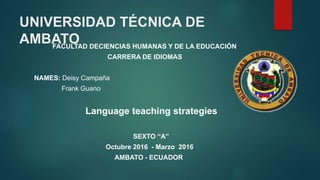
L.t.s second language acquisition theory.
- 1. UNIVERSIDAD TÉCNICA DE AMBATOFACULTAD DECIENCIAS HUMANAS Y DE LA EDUCACIÓN CARRERA DE IDIOMAS NAMES: Deisy Campaña Frank Guano Language teaching strategies SEXTO “A” Octubre 2016 - Marzo 2016 AMBATO - ECUADOR
- 2. Second Language Acquisition Theory Five Hypotheses About Second Language Acquisition 1. THE ACQUISITION-LEARNING DISTINCTION The acquisition-learning hypothesis claims, however, that adults also acquire, that the ability to "pick-up“ languages does not disappear at puberty. This does not mean that adults will always be able to achieve native-like levels in a second language. It does mean that adults can access the same natural "language acquisition device" that children use. As we shall see later, acquisition is a very powerful process in the adult.
- 3. 2. THE NATURAL ORDER HYPOTHESIS Stephen Krashen claimed that we acquire the language rules in a predictable or natural order. He noticedthat language features that are the easiest to state are not always the first be acquired. For example, the progressive marker ing (as in "He is playing baseball".) and the plural marker /s/ ("two dogs") were among the first morphemes acquired, while the third person singular marker /s/ (as in "He lives in New York") and the possessive /s/ ("John's hat") were typically acquired much later,
- 4. 3. THE MONITOR HYPOTHESIS It is a device to monitor or edit the learner`s output. It is supposed to be responsible for editing, making correction consciously. This is why it is found in the learning process not the acquisition. Only once fluency established, monitoring and editing should be activated.
- 5. 4 THE INPUT HYPOTHESIS Comprehensible input is the only true cause of second language acquisition. An important condition for language acquisition to occur is that the learners understand input language that contain structure a bit beyond his current level of competence.
- 6. 5. THE AFFECTIVE FILTER HYPOTHESIS Affect refers to the feelings, motives, needs, attitudes, and emotional states. Affective filter is a metaphorical barrier that prevents learners from acquiring language even when the appropriate input is available. That the best acquisition will occur in environment where anxiety is low and defensiveness absent. A learner who is tense anxious may filter out the input, making it unavailable for acquisition.
- 7. The Causative Variable in Second Language Acquisition 1. THE CAUSATIVE VARIABLES 1. Acquisition is more important than learning. 2. In order to acquire, two conditions are necessary. The first is comprehensible input “i + 1” The second, a low or weak affective filter to allow the input "in".
- 8. 2. LANGUAGE TEACHING: DOES IT HELP? language teaching helps when it is the main source of low filter comprehensible input, that is, for beginners and for foreign language students who do not have a chance to get input outside the class. Its primary function is to supply comprehensible input for those who can not get it elsewhere, (i.e. foreign language students who do not have input sources outside the class) or by their competence (those unable to understand the language of the outside world).
- 9. 3. EXPOSURE VARIABLES LENGTH OF RESIDENCE (LOR) • May reflect simply the amount of comprehensible input the child obtains. • Fathman (1975) was discussed above. in addition to her finding on the non-effects of formal instruction on ESL achievement, Fathman also reported that LOR did predict proficiency for her sample of children (ages 6-14, enrolled in public school in Washington, D.C.).
- 10. Walberg, Hase, and Rasher (1978) studied Japanese-speaking children who had been in the United States a range of zero to 12 years. They find a significant relationship between LOR and proficiency in English as a second language, but noted that even higher correlations were found with a "diminishing returns" model: "For children of all ages in the sample, acquisition proceeds at a fast rate initially, but the amounts of gain diminish with time"
- 11. 4. AGE Krashen, Long, and Scarcella (1979) reviewed the available empirical research on the effect of age and second language acquisition 1. Adults proceed through the early stages of second language development faster than children do (where time and exposure are held constant). 2. Older children acquire faster than younger children, time and exposure held constant. 3. Acquirers who begin natural exposure to second languages during childhood generally achieve higher second language proficiency than those beginning as adults.
- 12. 5. Schumann's Acculturation Hypothesis. "Second language acquisition is just one aspect of acculturation, and the degree to which the learner acculturates to the target language group will control the degree to which he acquires the target language"
- 13. Schumann defines two types of acculturation: The learner is socially integrated with the TL group and, as a result, develops sufficient contact with TL speakers to enable him to acquire the TL. In addition, he is psychologically open to the TL such that input to which he is exposed becomes intake. All the characteristics of type one, but in this case the learner regards the TL speakers as a reference